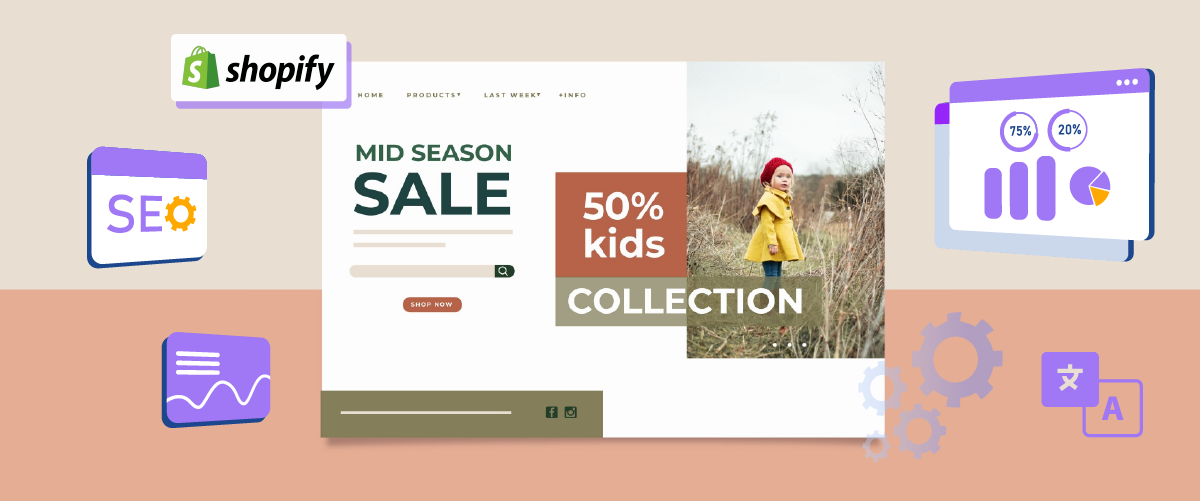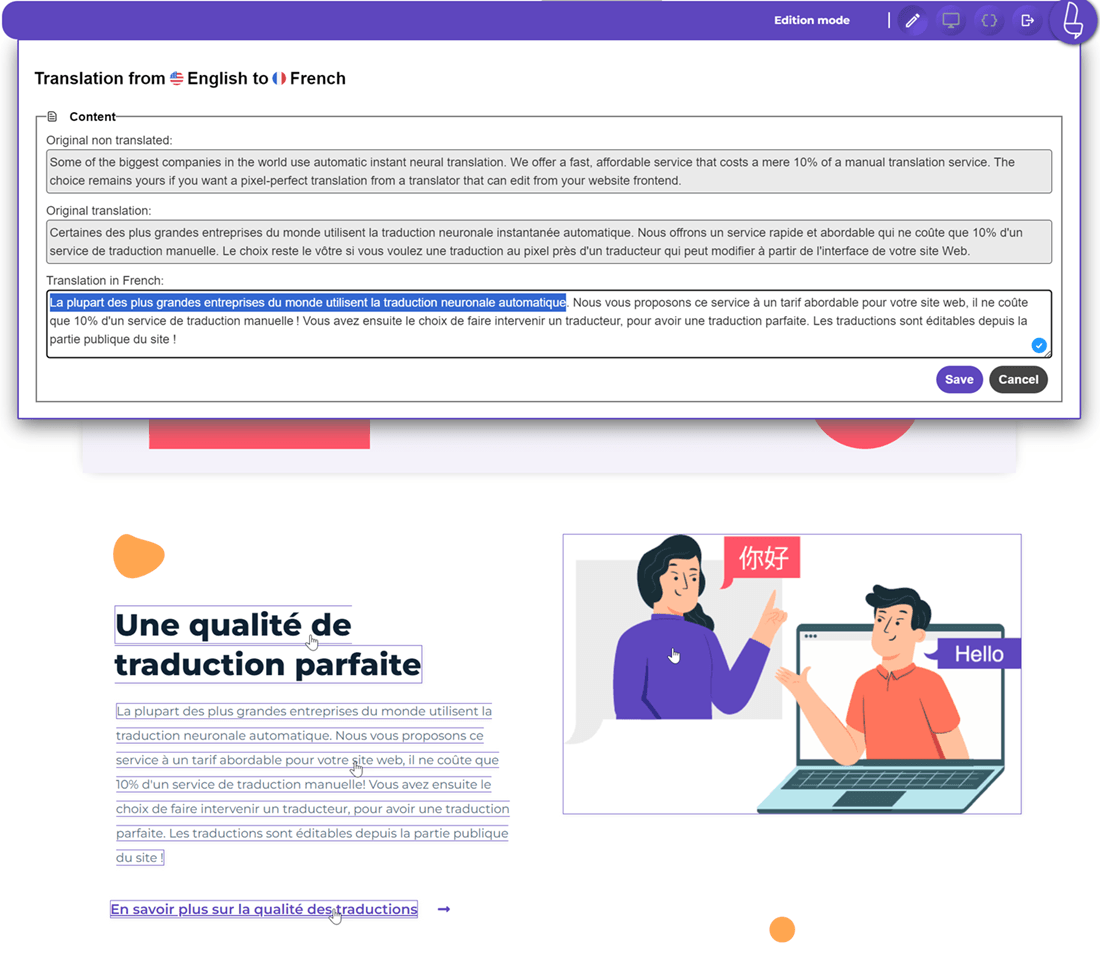Multilingual SEO for Shopify stores is essential. With Shopify being a top platform for e-commerce and online shopping growing rapidly worldwide, optimizing your store for multiple languages can significantly boost your visibility and sales. This is especially important as more people shop from international stores, with the cross-border market expected to reach €881 billion in 2020.
This article will provide practical tips to improve your Shopify store’s multilingual SEO. By following these strategies, you can attract customers from different countries, expand your market reach, and increase your online success in various languages and regions.
Why should you boost multi-language SEO for the Shopify store?

By 2024, it is estimated that more than 4.4 billion online stores will use the Shopify platform, with an average of 2.1 million daily active users. This shows the potential of the global e-commerce market.
So, with that big potential, are you interested in expanding your Shopify store to international markets? If so, a multi-language SEO strategy could be your right approach.
By optimizing content in multiple languages, you can tap into new markets that you haven’t targeted before. Your products will appear in local search results in various countries, significantly increasing your store’s global visibility.
Not only that, by presenting content in your customers’ local language, you can enhance the user experience, because 76% of consumers prefer to purchase products in their language. Adopting this strategy increases traffic and improves conversion opportunities!
In the end, Shopify stores that implement a multi-language SEO strategy can expand their market reach, enhance customer shopping experiences, and potentially increase sales conversion opportunities.
So, are you ready to expand your Shopify store internationally? If so, stay tuned for the tips we’ll discuss below!
10 tips to boost multi-language SEO for your Shopify store
Boosting multi-language SEO for your Shopify store is essential in expanding your global business reach. Here are 10 tips that can help you optimize your Shopify store for different languages and markets.
Localized keyword research
Local keyword research is a crucial foundation in a multilingual SEO strategy. It’s not just about translating keywords from your native language but also about understanding how customers in the target market search for your products. You can also localize content to match these keywords.
Use tools like Google Keyword Planner or Ahrefs with specific location and language settings. Pay attention to cultural and linguistic variations. For example, “running shoes” may be translated differently in Spain (“zapatillas de running”) and Mexico (“tenis para correr”). An online shoe store entering the Latin American market needs to understand these differences to optimize its content accurately.
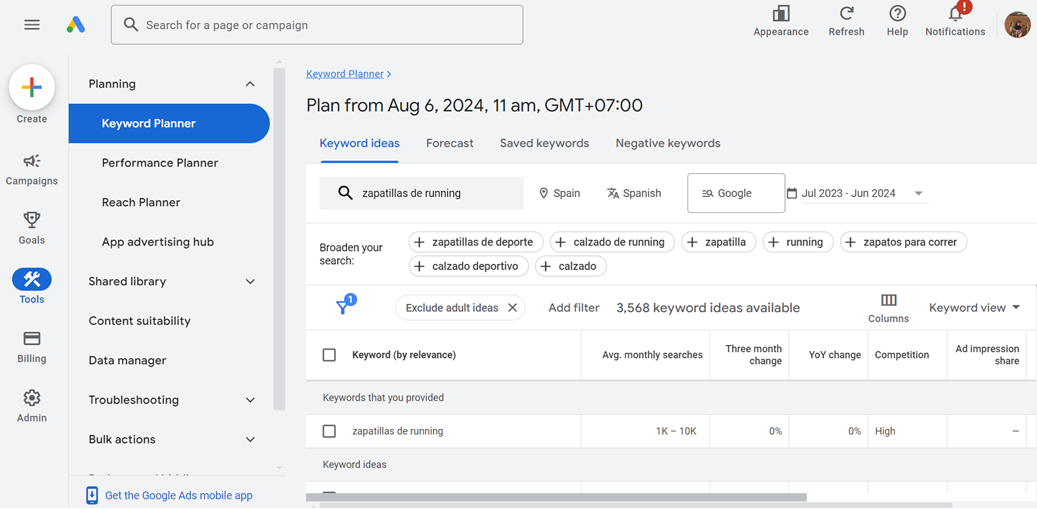
Unique URL and domain structure
A unique URL structure and domain are crucial for multilingual SEO. This helps search engines and users identify the relevant language version of your site.
There are several approaches you can take. You can use subdomains (fr.yourstore.com), subdirectories (yourstore.com/fr/), or country code top-level domains (yourstore.fr). Your choice will depend on your internationalization strategy. For example, Amazon uses country code top-level domains (amazon.fr, amazon.de) for their major markets, helping them build strong domain authority in each country.
Here is an example of a URL with a subdomain structure for English.
Until it was translated into Italian.
Use hreflang tags
The Shopify hreflang tag is a crucial element in multilingual SEO. This tag signals to search engines the language and regional relationships between pages on your site, ensuring users are directed to the version that best matches their language and location preferences.
Implement the hreflang tag in your HTML code’s <head> section or in the XML sitemap. For example, an international news site might use the hreflang tag to manage different language versions of the same article. Here is an example of implementing the hreflang tag for a homepage in three languages.
<head>
<link rel="alternate" hreflang="en" href="https://www.yourstore.com/en/" />
<link rel="alternate" hreflang="es" href="https://www.yourstore.com/es/" />
<link rel="alternate" hreflang="id" href="https://www.yourstore.com/id/" />
<link rel="alternate" hreflang="x-default" href="https://www.yourstore.com/" /> <script type="application/ld+json" class="gnpub-schema-markup-output">{"@context":"https:\/\/schema.org\/","@type":"NewsArticle","@id":"https:\/\/www.linguise.com\/blog\/guide\/how-to-boost-multi-language-seo-for-shopify-store\/#newsarticle","url":"https:\/\/www.linguise.com\/blog\/guide\/how-to-boost-multi-language-seo-for-shopify-store\/","image":{"@type":"ImageObject","url":"https:\/\/www.linguise.com\/wp-content\/uploads\/2024\/08\/FI_How-to-boost-multi-language-SEO-for-Shopify-150x150.png","width":150,"height":150},"headline":"How to boost multi-language SEO for Shopify store","mainEntityOfPage":"https:\/\/www.linguise.com\/blog\/guide\/how-to-boost-multi-language-seo-for-shopify-store\/","datePublished":"2024-08-08T09:44:39+00:00","dateModified":"2024-09-20T07:19:54+00:00","description":"Do you have a Shopify store and want to expand your customer reach? Let's start boost multi-language for Shopify store","articleSection":"Guide","articleBody":"Multilingual SEO for Shopify stores is essential. With Shopify being a top platform for e-commerce and online shopping growing rapidly worldwide, optimizing your store for multiple languages can significantly boost your visibility and sales. This is especially important as more people shop from international stores, with the cross-border market expected to reach \u20ac881 billion in 2020.This article will provide practical tips to improve your Shopify store's multilingual SEO. By following these strategies, you can attract customers from different countries, expand your market reach, and increase your online success in various languages and regions.\t\t\n\t\t\tWhy should you boost multi-language SEO for the Shopify store?\t\t\n\t\t\t\t\t\t\t\t\t\t\t\t\t\t\t\t\t\t\t\t\t\t\t\t\t\t\n\t\tBy 2024, it is estimated that more than 4.4 billion online stores will use the Shopify platform, with an average of 2.1 million daily active users. This shows the potential of the global e-commerce market.So, with that big potential, are you interested in expanding your Shopify store to international markets? If so, a multi-language SEO strategy could be your right approach.By optimizing content in multiple languages, you can tap into new markets that you haven't targeted before. Your products will appear in local search results in various countries, significantly increasing your store's global visibility.Not only that, by presenting content in your customers' local language, you can enhance the user experience, because 76% of consumers prefer to purchase products in their language. Adopting this strategy increases traffic and improves conversion opportunities!In the end, Shopify stores that implement a multi-language SEO strategy can expand their market reach, enhance customer shopping experiences, and potentially increase sales conversion opportunities.So, are you ready to expand your Shopify store internationally? If so, stay tuned for the tips we'll discuss below!\t\t\n\t\t\t\t\t\tBreak Language Barriers\t\t\t\t\t\n\t\t\t\t\t\tSay goodbye to language barriers and hello to limitless growth! Try our automatic translation service today.\t\t\t\t\t\n\t\t\t\t\t\n\t\t\t\t\t\tStart Translating Now\t\t\t\t\t\n\t\t\t10 tips to boost multi-language SEO for your Shopify store \n\t\t\n\t\tBoosting multi-language SEO for your Shopify store is essential in expanding your global business reach. Here are 10 tips that can help you optimize your Shopify store for different languages \u200b\u200band markets.\t\t\n\t\t\tLocalized keyword research\n\t\t\n\t\tLocal keyword research is a crucial foundation in a multilingual SEO strategy. It\u2019s not just about translating keywords from your native language but also about understanding how customers in the target market search for your products. You can also localize content to match these keywords.Use tools like Google Keyword Planner or Ahrefs with specific location and language settings. Pay attention to cultural and linguistic variations. For example, \"running shoes\" may be translated differently in Spain (\"zapatillas de running\") and Mexico (\"tenis para correr\"). An online shoe store entering the Latin American market needs to understand these differences to optimize its content accurately.\t\t\n\t\t\t\t\t\t\t\t\t\t\t\t\t\t\t\t\t\t\t\t\t\t\t\t\t\t\n\t\t\tUnique URL and domain structure\n\t\t\n\t\tA unique URL structure and domain are crucial for multilingual SEO. This helps search engines and users identify the relevant language version of your site.There are several approaches you can take. You can use subdomains (fr.yourstore.com), subdirectories (yourstore.com\/fr\/), or country code top-level domains (yourstore.fr). Your choice will depend on your internationalization strategy. For example, Amazon uses country code top-level domains (amazon.fr, amazon.de) for their major markets, helping them build strong domain authority in each country.Here is an example of a URL with a subdomain structure for English.\t\t\n\t\t\t\t\t\t\t\t\t\t\t\t\t\t\t\t\t\t\t\t\t\t\t\t\t\t\n\t\tUntil it was translated into Italian.\t\t\n\t\t\t\t\t\t\t\t\t\t\t\t\t\t\t\t\t\t\t\t\t\t\t\t\t\t\n\t\t\tUse hreflang tags\n\t\t\n\t\tThe Shopify hreflang tag is a crucial element in multilingual SEO. This tag signals to search engines the language and regional relationships between pages on your site, ensuring users are directed to the version that best matches their language and location preferences.Implement the hreflang tag in your HTML code's <head> section or in the XML sitemap. For example, an international news site might use the hreflang tag to manage different language versions of the same article. Here is an example of implementing the hreflang tag for a homepage in three languages.\t\t\n\t\t\t\n\t\t\t\t\n\t\t\t\t\t\n \n \n \n \n\n\n\t\t\t\t\n\t\t\t\n\t\tIn this example, the hreflang tag indicates the page's English, Spanish, and Indonesian versions and the default version (x-default) for users who do not match the specific languages offered. Proper use of the hreflang tag helps search engines display the most relevant results for users based on their language and location, enhancing user experience and click potential.\t\t\n\t\t\tOptimize title and metadata\n\t\t\n\t\t\t\t\t\t\t\t\t\t\t\t\t\t\t\t\t\t\t\t\t\t\t\t\t\t\n\t\tOptimizing page titles and metadata in each language is key to improving visibility in search results. It\u2019s not just about translating but also adapting the content for the local audience.Ensure that relevant local keywords are included and that the text stays within the recommended character limits (around 60 characters for titles and 160 for meta descriptions). For example, Zara, a global fashion brand, consistently optimizes the titles and descriptions of their products for each market, incorporating local keywords and adjusting the tone to match local cultural preferences.\t\t\n\t\t\tUse a friendly language switcher\n\t\t\n\t\tA user-friendly language switcher is a crucial component in the design of a multilingual website. It allows visitors to quickly find and switch to their desired language version.Place the language switcher in a prominent location, typically in the site's header or footer. Use country flags cautiously, as some languages are used in multiple countries. You can use a combination of country flags and language names or country flags and country names. For example, Airbnb\u2019s website has a clear language selector in the upper right corner, marked with a globe icon on every page. When clicked, it displays various language and country options, including currency choices.\t\t\n\t\t\t\t\t\t\t\t\t\t\t\t\t\t\t\t\t\t\t\t\t\t\t\t\t\t\n\t\t\tImage optimization\n\t\t\n\t\t\t\t\t\t\t\t\t\t\t\t\t\t\t\t\t\t\t\t\t\t\t\t\t\t\n\t\tImage optimization is a crucial aspect of multilingual SEO for your Shopify store. It\u2019s about reducing file size for faster loading and making your images discoverable and understandable by search engines in various languages.Start by giving descriptive and relevant filenames in the target language. Then, focus on alt text. Alt text should be brief yet descriptive and contain relevant keywords in that language. For example, an international clothing store like Uniqlo might use the alt text \"chemise en lin blanc pour homme\" to image a men's white linen shirt on their French version rather than translating \"white linen shirt for men.\"Apart from that, compressed image size is also an image optimization option. Because a file size that is too large can make the load speed slower.\t\t\n\t\t\tOptimize for local search engines\t\t\n\t\t\t\t\t\t\t\t\t\t\t\t\t\t\t\t\t\t\t\t\t\t\t\t\t\t\n\t\tAlthough Google dominates many countries, some markets have popular local search engines. Optimizing for these search engines can provide a significant competitive advantage.For example, if you are targeting the Russian market, optimizing for Yandex is as important as optimizing for Google. In China, focusing on Baidu is crucial. Each of these search engines has unique algorithms and preferences. For instance, Baidu prefers content in Mandarin and local hosting. Alibaba, the Chinese e-commerce giant, has been very successful because it optimizes well for Baidu, helping it dominate the Chinese e-commerce market.Local schema is also a way to tell search engines about your local business. It\u2019s like giving out a complete\u00a0custom business card. You add a special code to your website that contains information such as address, phone number and opening hours. With this, it is easier for search engines to display your business information in local search results.\t\t\n\t\t\tUse automatic translation service\n\t\t\n\t\tYou can use automatic translation services to facilitate the translation of online store content into various languages. This helps you expand your market reach without significantly investing in manual translation. These services can quickly translate product descriptions, information pages, and blog content. However, the translation results may need to be reviewed to ensure accuracy and cultural appropriateness.Linguise is a service that integrates with Shopify and other e-commerce platforms. This service offers high-accuracy AI-based automatic translation, a front-end live editor, the ability to translate dynamic content from JavaScript, and additional features such as SEO translation and automatic language detection. With these features, Linguise helps Shopify store owners optimize their multilingual strategy.\t\t\n\n\t\t\n\t\t\n\t\t\n\n \n \n Edition mode \n\n Original \n\n Translations \n\n Click & edit \n\n Links \n\n Images \n\t\t\n\t\t\tHigh-quality translation of each language\n\t\t\n\t\tHigh-quality translation is at the core of an effective multilingual SEO strategy. It\u2019s not just about linguistic accuracy but also about conveying cultural nuances and local context.Use professional translators or native speakers to translate your content. They can capture idioms, slang, and cultural references that may be lost in machine translation. However, if you are using app to translate Shopify, you should ensure that the results are accurate and of high quality, such as the accuracy results table for several languages provided by Linguise below.\n\n\n \nNMT Translation\nHuman Translation\nQuality\n\n\nEnglish-Spanish\n5,428\n5,550\n97%\n\n\nEnglish-French\n5,295\n5,496\n96%\n\n\nEnglish-Chinese\n4,594\n4,987\n92%\n\n\nSpanish-English\n5,187\n5,372\n96%\n\n\nFrench-English\n5,343\n5,404\n98%\n\n\nChinese-English\n4,263\n4,636\n92%\n\n\nTherefore, choose a high-quality automatic translation service in every language for your multilingual Shopify store.\t\t\n\t\t\tOptimize loading speed for all language versions\n\t\t\n\t\t\t\t\t\t\t\t\t\t\t\t\t\t\t\t\t\t\t\t\t\t\t\t\t\t\n\t\tLoading speed is an important factor in SEO and applies to all language versions of your Shopify store. Faster sites enhance user experience and improve search rankings.Use techniques such as image compression, minification of CSS and JavaScript, and browser caching for all language versions. Also, consider using a Content Delivery Network (CDN) to serve content from servers closer to users. For example, ASOS, a global online fashion retailer, uses a CDN to ensure consistent loading speeds across all its markets, from the UK to Australia.\t\t\n\t\t\tSocial media and local communities\n\t\t\n\t\t\t\t\t\t\t\t\t\t\t\t\t\t\t\t\t\t\t\t\t\t\t\t\t\t\n\t\tSocial media and local communities are vital in a multilingual SEO strategy. Engagement on these platforms increases brand visibility and supports SEO through enhanced traffic and backlinks. The first step is to identify the popular social media platforms in your target market. Next, create content that aligns with local language and culture, not just translations. Engaging with local online communities, such as discussion forums and Facebook groups, is crucial for building authority and driving traffic.Collaborating with local influencers can significantly expand your reach. They understand local audience preferences and can convey your brand message effectively. Finally, leverage user-generated content in your strategy. Encouraging customers to share their experiences in their language creates authentic and locally relevant content, enhancing engagement and brand trust.\t\t\n\t\t\t\t\t\tReady to explore new markets? Try our automatic translation service for free with our 1-month risk-free trial. No credit card needed!\t\t\t\t\t\n\t\t\t\t\t\n\t\t\t\t\t\tClaim Your 1-Month Free Trial\t\t\t\t\t\n\t\t\tExample of multilingual Shopify stores that successfully implement SEO\t\t\n\t\tNow, you know the tips for boosting multi-language SEO for your Shopify storeHere are some success stories of Shopify stores that successfully implemented SEO to further convince you of the importance of SEO for Shopify stores.\t\t\n\t\t\tExample 1: Alef Meem\n\t\t\n\t\t\t\t\t\t\t\t\t\t\t\t\t\t\t\t\t\t\t\t\t\t\t\t\t\t\n\t\tAlef Meem is an online store in the United Arab Emirates (UAE) that sells comfortable, elegant, and breathable prayer clothing for women. Founded in 2019, It aims to celebrate the practice of prayer and Islamic values through its clothing.Problem:Alef Meem faced an issue because its website was only available in English, while the majority of its customers were Emiratis and Arabic speakers. Additionally, its website design could have been more appealing and fully reflected traditional and Islamic values. The website must be optimized for mobile users and adhere to the best SEO practices.Solution:Alef Meem took several steps to address these issues.\u00a0Integrated a robust multilingual support system on their Shopify website, allowing users to switch between English and Arabic easily.They optimized SEO by implementing best practices, including keyword optimization, strategic meta tag usage, and creating informative content with targeted keywords.Result:The results were impressive! Alef Meem saw increased customer engagement due to the bilingual interface and user-friendly design. They also experienced a significant rise in conversion rates thanks to the easy-to-use design, fast loading times, and simplified checkout process. Their search engine rankings significantly improved, enhancing their online visibility and resulting in substantial growth in organic traffic and an expanded customer base.\t\t\n\t\t\tExample 2: Jimmy Fairly\n\t\t\n\t\t\t\t\t\t\t\t\t\t\t\t\t\t\t\t\t\t\t\t\t\t\t\t\t\t\n\t\tJimmy Fairly is an eyewear brand from France known for designing, producing, and selling high-quality eyewear at reasonable prices. They eliminate middlemen in the production and sales process, allowing them to offer more affordable prices to customers.Problem:Jimmy Fairly found that 19% of their sales came from international markets. However, they did not have English content to serve this growing global market. They needed a quick and efficient website translation solution to reach increasing international customers.Solution:To solve this problem, Jimmy Fairly used an automatic translation tool to generate content in languages other than English and applied SEO so their content would appear in customer searches.Result:The results were remarkable. Jimmy Fairly's international sales quadrupled from previous levels within just one month of implementing automatic translations. Even more impressively, after 8 months, they increased sixfold. This dramatic sales increase highlights the importance of providing content in the languages understood by the target market, especially when entering international markets.\t\t\n\t\t\tConclusion\t\t\n\t\t\t\t\t\t\t\t\t\t\t\t\t\t\t\t\t\t\t\t\t\t\t\t\t\t\n\t\tOptimizing multilingual SEO for your Shopify store is crucial in expanding your global reach and enhancing online visibility. Implementing the strategies mentioned above, such as local keyword research, using hreflang tags, and optimizing content for local search engines, can improve search rankings and attract more international customers.Consider using high-quality automatic translation services like Linguise to facilitate your content's translation and localization process. With advanced features such as AI-based translation, the ability to translate dynamic content, and seamless integration with Shopify, Linguise can help you implement your multilingual strategy efficiently and effectively. Let's create your Linguise account and try to translate your Shopify automatically.","keywords":"","name":"How to boost multi-language SEO for Shopify store","thumbnailUrl":"https:\/\/www.linguise.com\/wp-content\/uploads\/2024\/08\/FI_How-to-boost-multi-language-SEO-for-Shopify-150x150.png","wordCount":2161,"timeRequired":"PT9M36S","mainEntity":{"@type":"WebPage","@id":"https:\/\/www.linguise.com\/blog\/guide\/how-to-boost-multi-language-seo-for-shopify-store\/"},"author":{"@type":"Person","name":"Aorinka Anendya","url":"https:\/\/www.linguise.com\/author\/aorinka\/","sameAs":[],"image":{"@type":"ImageObject","url":"https:\/\/secure.gravatar.com\/avatar\/f96846f24c8259f1c8e7eb0342d44ba09f57b51b37a2734d532085b243e2688b?s=96&d=mm&r=g","height":96,"width":96}},"editor":{"@type":"Person","name":"Aorinka Anendya","url":"https:\/\/www.linguise.com\/author\/aorinka\/","sameAs":[],"image":{"@type":"ImageObject","url":"https:\/\/secure.gravatar.com\/avatar\/f96846f24c8259f1c8e7eb0342d44ba09f57b51b37a2734d532085b243e2688b?s=96&d=mm&r=g","height":96,"width":96}}}</script> </head>
In this example, the hreflang tag indicates the page’s English, Spanish, and Indonesian versions and the default version (x-default) for users who do not match the specific languages offered. Proper use of the hreflang tag helps search engines display the most relevant results for users based on their language and location, enhancing user experience and click potential.
Optimize title and metadata

Optimizing page titles and metadata in each language is key to improving visibility in search results. It’s not just about translating but also adapting the content for the local audience.
Ensure that relevant local keywords are included and that the text stays within the recommended character limits (around 60 characters for titles and 160 for meta descriptions). For example, Zara, a global fashion brand, consistently optimizes the titles and descriptions of their products for each market, incorporating local keywords and adjusting the tone to match local cultural preferences.
Use a friendly language switcher
A user-friendly language switcher is a crucial component in the design of a multilingual website. It allows visitors to quickly find and switch to their desired language version.
Place the language switcher in a prominent location, typically in the site’s header or footer. Use country flags cautiously, as some languages are used in multiple countries. You can use a combination of country flags and language names or country flags and country names. For example, Airbnb’s website has a clear language selector in the upper right corner, marked with a globe icon on every page. When clicked, it displays various language and country options, including currency choices.
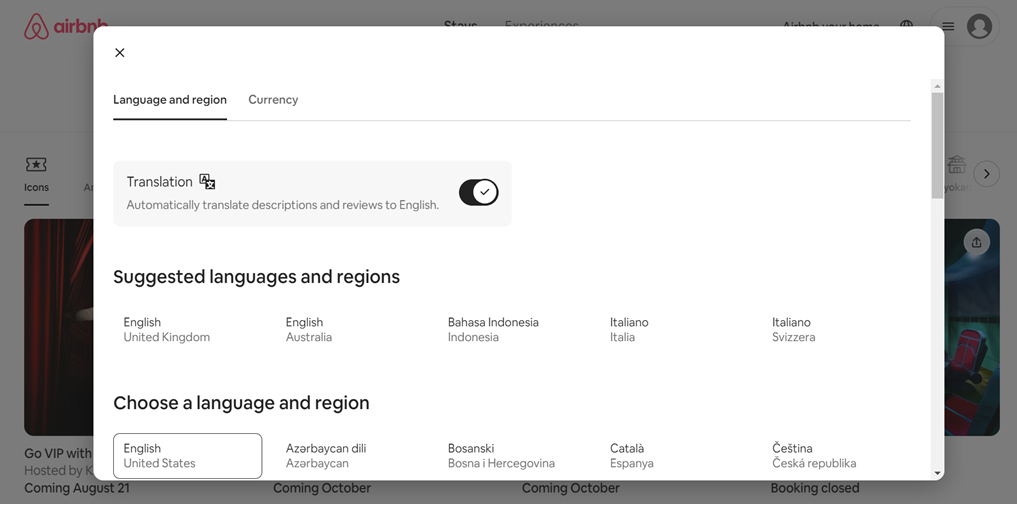
Image optimization

Image optimization is a crucial aspect of multilingual SEO for your Shopify store. It’s about reducing file size for faster loading and making your images discoverable and understandable by search engines in various languages.
Start by giving descriptive and relevant filenames in the target language. Then, focus on alt text. Alt text should be brief yet descriptive and contain relevant keywords in that language. For example, an international clothing store like Uniqlo might use the alt text “chemise en lin blanc pour homme” to image a men’s white linen shirt on their French version rather than translating “white linen shirt for men.”
Apart from that, compressed image size is also an image optimization option. Because a file size that is too large can make the load speed slower.
Optimize for local search engines

Although Google dominates many countries, some markets have popular local search engines. Optimizing for these search engines can provide a significant competitive advantage.
For example, if you are targeting the Russian market, optimizing for Yandex is as important as optimizing for Google. In China, focusing on Baidu is crucial. Each of these search engines has unique algorithms and preferences. For instance, Baidu prefers content in Mandarin and local hosting. Alibaba, the Chinese e-commerce giant, has been very successful because it optimizes well for Baidu, helping it dominate the Chinese e-commerce market.
Local schema is also a way to tell search engines about your local business. It’s like giving out a complete custom business card. You add a special code to your website that contains information such as address, phone number and opening hours. With this, it is easier for search engines to display your business information in local search results.
Use automatic translation service
You can use automatic translation services to facilitate the translation of online store content into various languages. This helps you expand your market reach without significantly investing in manual translation. These services can quickly translate product descriptions, information pages, and blog content. However, the translation results may need to be reviewed to ensure accuracy and cultural appropriateness.
Linguise is a service that integrates with Shopify and other e-commerce platforms. This service offers high-accuracy AI-based automatic translation, a front-end live editor, the ability to translate dynamic content from JavaScript, and additional features such as SEO translation and automatic language detection. With these features, Linguise helps Shopify store owners optimize their multilingual strategy.
High-quality translation of each language
High-quality translation is at the core of an effective multilingual SEO strategy. It’s not just about linguistic accuracy but also about conveying cultural nuances and local context.
Use professional translators or native speakers to translate your content. They can capture idioms, slang, and cultural references that may be lost in machine translation. However, if you are using app to translate Shopify, you should ensure that the results are accurate and of high quality, such as the accuracy results table for several languages provided by Linguise below.
| Language Pair | Google AI vs human | Linguise AI vs human |
| English > Spanish | 93% | 99% |
| English > French | 93% | 99% |
| English > Chinese | 92% | 98% |
| Spanish > English | 92% | 98% |
| French > English | 92% | 98% |
| Chinese > English | 91% | 97% |
| English > German | 91% | 99% |
| English > Portuguese | 90% | 99% |
| English > Japanese | 88% | 97% |
| English > Arabic | 87% | 97% |
Therefore, choose a high-quality automatic translation service in every language for your multilingual Shopify store.
Optimize loading speed for all language versions
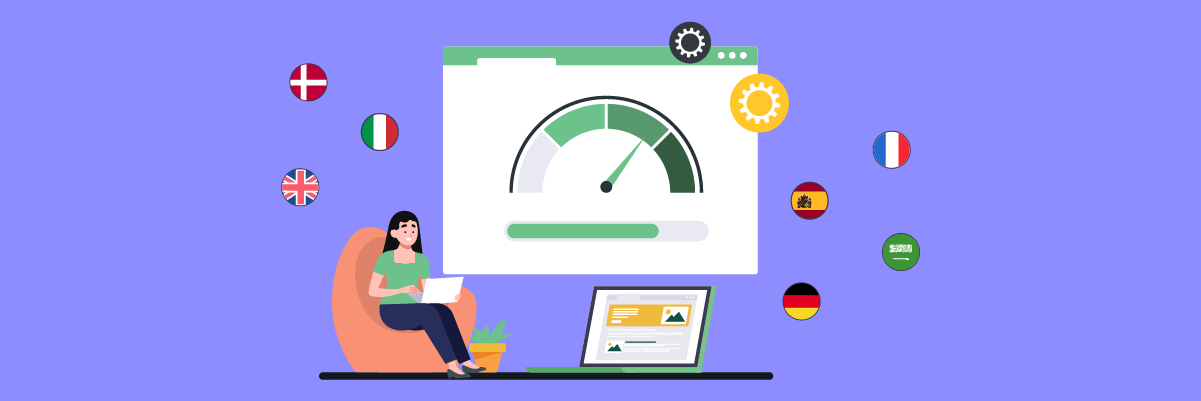
Loading speed is an important factor in SEO and applies to all language versions of your Shopify store. Faster sites enhance user experience and improve search rankings.
Use techniques such as image compression, minification of CSS and JavaScript, and browser caching for all language versions. Also, consider using a Content Delivery Network (CDN) to serve content from servers closer to users. For example, ASOS, a global online fashion retailer, uses a CDN to ensure consistent loading speeds across all its markets, from the UK to Australia.
Social media and local communities

Social media and local communities are vital in a multilingual SEO strategy. Engagement on these platforms increases brand visibility and supports SEO through enhanced traffic and backlinks. The first step is to identify the popular social media platforms in your target market. Next, create content that aligns with local language and culture, not just translations. Engaging with local online communities, such as discussion forums and Facebook groups, is crucial for building authority and driving traffic.
Collaborating with local influencers can significantly expand your reach. They understand local audience preferences and can convey your brand message effectively. Finally, leverage user-generated content in your strategy. Encouraging customers to share their experiences in their language creates authentic and locally relevant content, enhancing engagement and brand trust.
Example of multilingual Shopify stores that successfully implement SEO
Now, you know the tips for boosting multi-language SEO for your Shopify store
Here are some success stories of Shopify stores that successfully implemented SEO to further convince you of the importance of SEO for Shopify stores.
Example 1: Alef Meem
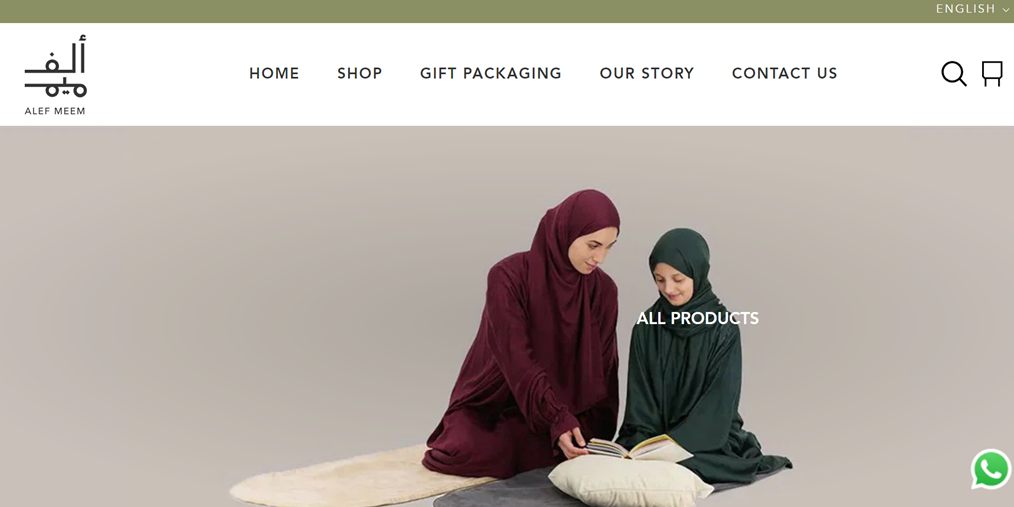
Alef Meem is an online store in the United Arab Emirates (UAE) that sells comfortable, elegant, and breathable prayer clothing for women. Founded in 2019, It aims to celebrate the practice of prayer and Islamic values through its clothing.
Problem:
Alef Meem faced an issue because its website was only available in English, while the majority of its customers were Emiratis and Arabic speakers. Additionally, its website design could have been more appealing and fully reflected traditional and Islamic values. The website must be optimized for mobile users and adhere to the best SEO practices.
Solution:
Alef Meem took several steps to address these issues.
- Integrated a robust multilingual support system on their Shopify website, allowing users to switch between English and Arabic easily.
- They optimized SEO by implementing best practices, including keyword optimization, strategic meta tag usage, and creating informative content with targeted keywords.
Result:
The results were impressive! Alef Meem saw increased customer engagement due to the bilingual interface and user-friendly design. They also experienced a significant rise in conversion rates thanks to the easy-to-use design, fast loading times, and simplified checkout process. Their search engine rankings significantly improved, enhancing their online visibility and resulting in substantial growth in organic traffic and an expanded customer base.
Example 2: Jimmy Fairly
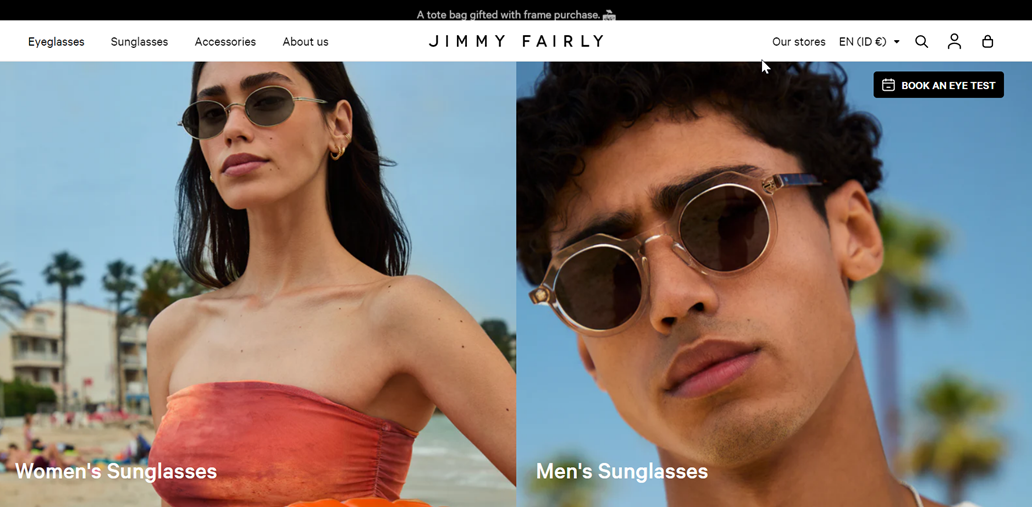
Jimmy Fairly is an eyewear brand from France known for designing, producing, and selling high-quality eyewear at reasonable prices. They eliminate middlemen in the production and sales process, allowing them to offer more affordable prices to customers.
Problem:
Jimmy Fairly found that 19% of their sales came from international markets. However, they did not have English content to serve this growing global market. They needed a quick and efficient website translation solution to reach increasing international customers.
Solution:
To solve this problem, Jimmy Fairly used an automatic translation tool to generate content in languages other than English and applied SEO so their content would appear in customer searches.
Result:
The results were remarkable. Jimmy Fairly’s international sales quadrupled from previous levels within just one month of implementing automatic translations. Even more impressively, after 8 months, they increased sixfold. This dramatic sales increase highlights the importance of providing content in the languages understood by the target market, especially when entering international markets.
Conclusion
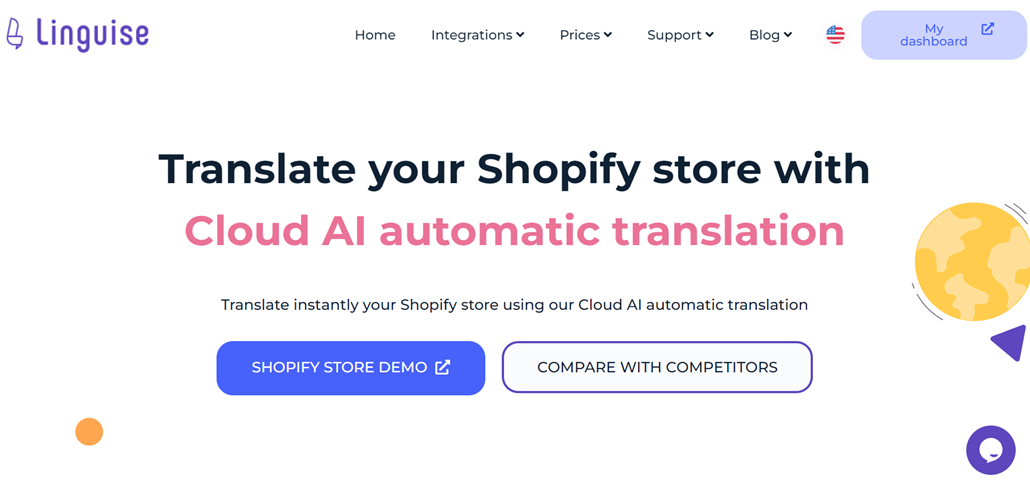
Optimizing multilingual SEO for your Shopify store is crucial in expanding your global reach and enhancing online visibility. Implementing the strategies mentioned above, such as local keyword research, using hreflang tags, and optimizing content for local search engines, can improve search rankings and attract more international customers.
Consider using high-quality automatic translation services like Linguise to facilitate your content’s translation and localization process. With advanced features such as AI-based translation, the ability to translate dynamic content, and seamless integration with Shopify, Linguise can help you implement your multilingual strategy efficiently and effectively. Let’s create your Linguise account and try to translate your Shopify automatically.

